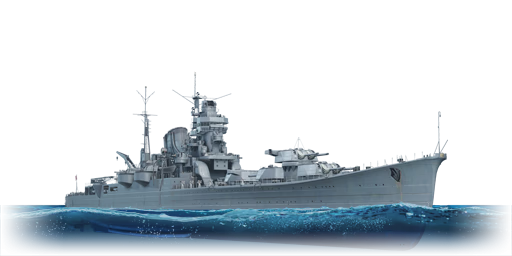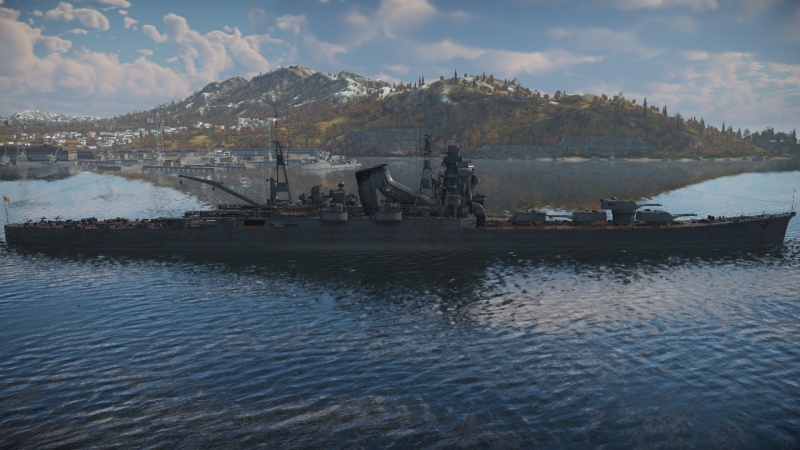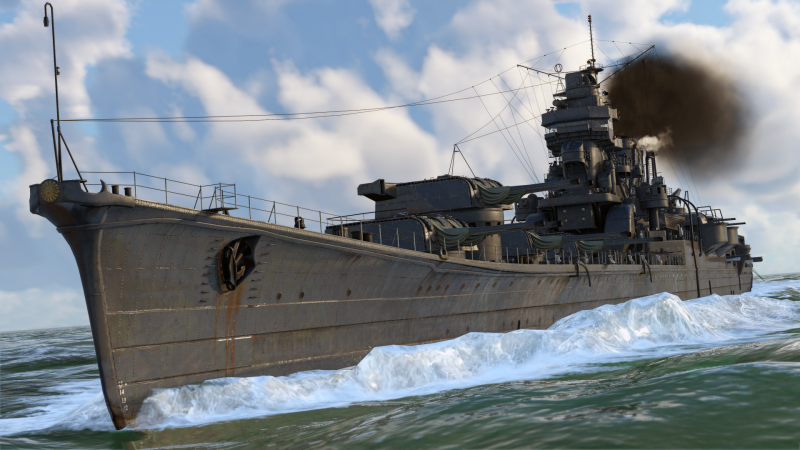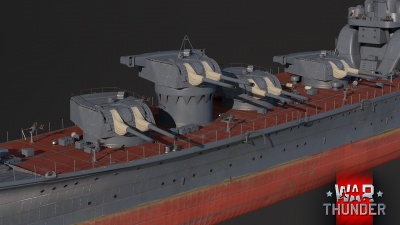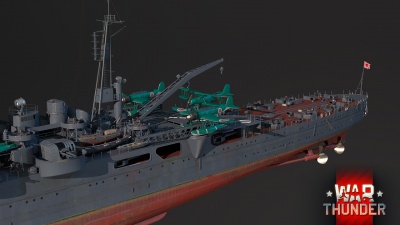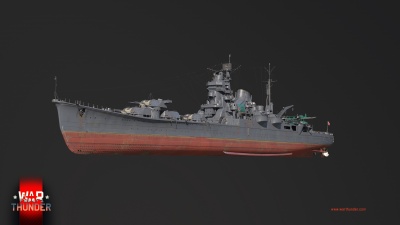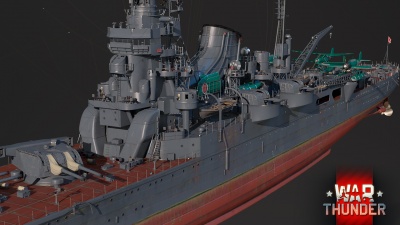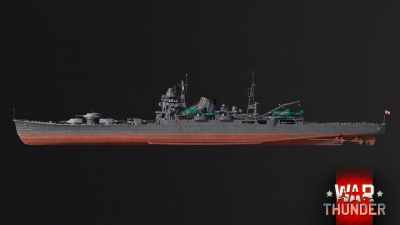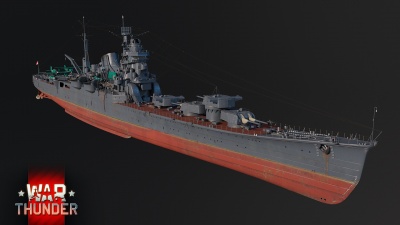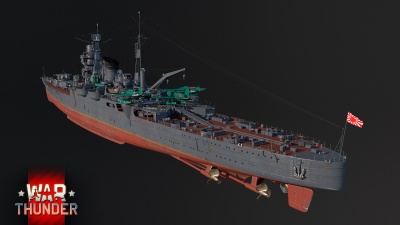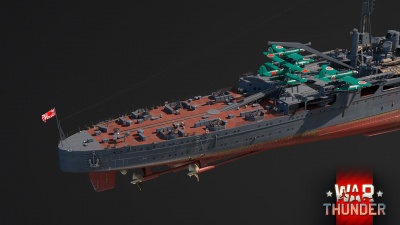Difference between revisions of "IJN Tone"
Jareel_Skaj (talk | contribs) |
|||
| (17 intermediate revisions by 8 users not shown) | |||
| Line 1: | Line 1: | ||
{{Specs-Card | {{Specs-Card | ||
|code=jp_cruiser_tone | |code=jp_cruiser_tone | ||
| − | |images={{Specs-Card-Image|GarageImage_{{PAGENAME}}.jpg}} | + | |images={{Specs-Card-Image|GarageImage_{{PAGENAME}}.jpg|ArtImage_{{PAGENAME}}.png}} |
}} | }} | ||
== Description == | == Description == | ||
<!-- ''In the first part of the description, cover the history of the ship's creation and military application. In the second part, tell the reader about using this ship in the game. Add a screenshot: if a beginner player has a hard time remembering vehicles by name, a picture will help them identify the ship in question.'' --> | <!-- ''In the first part of the description, cover the history of the ship's creation and military application. In the second part, tell the reader about using this ship in the game. Add a screenshot: if a beginner player has a hard time remembering vehicles by name, a picture will help them identify the ship in question.'' --> | ||
| − | [[ | + | '''Tone''' (利根, [[Abbreviations#.28JP.29_Naval|namesake]]: Tone River), the lead ship of her class, was laid down in December 1934, launched November 1937 and commissioned November 1938. Initially she was assigned to the Yokosuka Naval District but transferred to the Maizuru Naval District in December 1939. Alongside her sister ship Chikuma, Tone formed the 8th Cruiser Division and participated in major operations during the Pacific War, including the attack on Pearl Harbor on 7 December 1941, where her reconnaissance aircraft scouted Oahu and Maui islands before the strike. She took part in operations such as the Wake Island invasion, the Rabaul landing, the Dutch East Indies campaign, the Indian Ocean raid, and the Battle of Midway, where a malfunction in her catapult delayed the launch of reconnaissance aircraft. In March 1944, during [[wikipedia:Indian Ocean raid (1944)|Operation SA No.1]], Tone was involved in the sinking of the British merchant ship Behar, after which the treatment of prisoners led to the Behar Incident, resulting in war crimes trials post-war. Tone also participated in the Battle of the Eastern Solomons, the Battle of the Santa Cruz Islands, and the Battle of Leyte Gulf, where she suffered damage but remained operational. Later in the war, due to fuel shortages and damage from air attacks, Tone was converted into a training ship and finally, she was sunk by the dive bombers from carrier USS USS Monterey during the air raid on Kure Naval Base in July 1945. After the war, Tone was dismantled, and her materials were recycled for reconstruction efforts. |
| − | + | ||
| − | The '''{{Specs|name}}''' is a | + | The '''{{Specs|name}}''' is a Japanese heavy cruiser introduced in [[Update "Starfighters"]]. She can be easily recognised by having all four of her main gun turrets located in the bow section of the vessel, in front of the main superstructure. This concentration of the main guns allows her to have a fairly unusual firing angles and low spread of the broadside, but at the same time it creates a significant vulnerability, with all the ammunition stored in a single, obvious location, often leading to a chain reaction of explosions, blowing up the entire ship if even one of the [[ammo racks]] detonates. That said, the armour in that section is not negligible, and the vessel has overall relatively decent survivability, if enemies do not focus on the ammo racks. This is further assisted by Tone's impressive anti-air armament and excellent long-lance torpedoes giving her a fighting chance against bombers and battleships alike. Unlike most other Japanese cruisers, and despite the extensive aerial facilities aft of the superstructure, this refit lacks any hydroplanes, making her somewhat less capable of impacting the outcome of the battle. |
== General info == | == General info == | ||
| Line 35: | Line 35: | ||
''Provide information about the characteristics of the primary armament. Evaluate their efficacy in battle based on their reload speed, ballistics and the capacity of their shells. Add a link to the main article about the weapon: <code><nowiki>{{main|Weapon name (calibre)}}</nowiki></code>. Broadly describe the ammunition available for the primary armament, and provide recommendations on how to use it and which ammunition to choose.'' | ''Provide information about the characteristics of the primary armament. Evaluate their efficacy in battle based on their reload speed, ballistics and the capacity of their shells. Add a link to the main article about the weapon: <code><nowiki>{{main|Weapon name (calibre)}}</nowiki></code>. Broadly describe the ammunition available for the primary armament, and provide recommendations on how to use it and which ammunition to choose.'' | ||
| + | {{:20 cm/50 3rd year type No.2 (203 mm)/Ammunition|20.3 cm Type 0 HE, 20.3 cm Type 91 AP, 20.3 cm Type 0 HE-TF}} | ||
=== Secondary armament === | === Secondary armament === | ||
{{Specs-Fleet-Secondary}} | {{Specs-Fleet-Secondary}} | ||
| Line 40: | Line 41: | ||
{{main|5 inch/40 Type 89 (127 mm)}} | {{main|5 inch/40 Type 89 (127 mm)}} | ||
| − | + | {{:5 inch/40 Type 89 (127 mm)/Ammunition|127 mm HE, 127 mm HE-TF}} | |
=== Anti-aircraft armament === | === Anti-aircraft armament === | ||
| Line 49: | Line 50: | ||
''An important part of the ship's armament responsible for air defence. Anti-aircraft armament is defined by the weapon chosen with the control <code>Select anti-aircraft weapons</code>. Talk about the ship's anti-air cannons and machine guns, the number of guns and their positions, their effective range, and about their overall effectiveness – including against surface targets. If there are no anti-aircraft armaments, remove this section.'' | ''An important part of the ship's armament responsible for air defence. Anti-aircraft armament is defined by the weapon chosen with the control <code>Select anti-aircraft weapons</code>. Talk about the ship's anti-air cannons and machine guns, the number of guns and their positions, their effective range, and about their overall effectiveness – including against surface targets. If there are no anti-aircraft armaments, remove this section.'' | ||
| − | === | + | === Additional armament === |
| − | <!-- '' | + | {{Specs-Fleet-Additional}} |
| + | <!-- ''Describe the available additional armaments of the ship: depth charges, mines, torpedoes. Talk about their positions, available ammunition and launch features such as dead zones of torpedoes. If there is no additional armament, remove this section.'' --> | ||
{{main|Type 93 Model 1, Mod 2 (610 mm)}} | {{main|Type 93 Model 1, Mod 2 (610 mm)}} | ||
| Line 64: | Line 66: | ||
</gallery> | </gallery> | ||
--> | --> | ||
| − | |||
| − | |||
| − | |||
| − | |||
| − | |||
| − | |||
== Usage in battles == | == Usage in battles == | ||
<!-- ''Describe the technique of using this ship, the characteristics of her use in a team and tips on strategy. Abstain from writing an entire guide – don't try to provide a single point of view, but give the reader food for thought. Talk about the most dangerous opponents for this vehicle and provide recommendations on fighting them. If necessary, note the specifics of playing with this vehicle in various modes (AB, RB, SB).'' --> | <!-- ''Describe the technique of using this ship, the characteristics of her use in a team and tips on strategy. Abstain from writing an entire guide – don't try to provide a single point of view, but give the reader food for thought. Talk about the most dangerous opponents for this vehicle and provide recommendations on fighting them. If necessary, note the specifics of playing with this vehicle in various modes (AB, RB, SB).'' --> | ||
''Describe the technique of using this ship, the characteristics of her use in a team and tips on strategy. Abstain from writing an entire guide – don't try to provide a single point of view, but give the reader food for thought. Talk about the most dangerous opponents for this vehicle and provide recommendations on fighting them. If necessary, note the specifics of playing with this vehicle in various modes (AB, RB, SB).'' | ''Describe the technique of using this ship, the characteristics of her use in a team and tips on strategy. Abstain from writing an entire guide – don't try to provide a single point of view, but give the reader food for thought. Talk about the most dangerous opponents for this vehicle and provide recommendations on fighting them. If necessary, note the specifics of playing with this vehicle in various modes (AB, RB, SB).'' | ||
| − | |||
| − | |||
| − | |||
| − | |||
| − | |||
| − | |||
| − | |||
| − | |||
| − | |||
| − | |||
| − | |||
| − | |||
| − | |||
| − | |||
| − | |||
| − | |||
| − | |||
| − | |||
| − | |||
| − | |||
| − | |||
| − | |||
| − | |||
| − | |||
| − | |||
| − | |||
| − | |||
| − | |||
| − | |||
| − | |||
| − | |||
| − | |||
| − | |||
| − | |||
| − | |||
| − | |||
| − | |||
| − | |||
| − | |||
| − | |||
| − | |||
=== Pros and cons === | === Pros and cons === | ||
| Line 122: | Line 77: | ||
* Devastating anti-aircraft armament | * Devastating anti-aircraft armament | ||
| − | * 4 | + | * 4 turrets placed in the bow providing amazing firepower while staying in cover |
| + | * Fast torpedoes with amazing range and damage potential | ||
| + | * Powerful secondary guns for a Japanese cruiser | ||
| + | * 250 kg of anti-torpedo protection bulges along the hull and good belt armour make this a durable ship | ||
| + | * Like other Japanese cruisers, very fast in a straight line | ||
'''Cons:''' | '''Cons:''' | ||
* Turrets easily disabled due to very close proximity to each other | * Turrets easily disabled due to very close proximity to each other | ||
| + | * Awkward gun placement means enemy ships can flank you without resistance | ||
| + | * Torpedoes are difficult to launch without showing broadside | ||
| + | * Extremely poor armor on main battery turrets, even AA caliber guns can disable them | ||
== History == | == History == | ||
<!-- ''Describe the history of the creation and combat usage of the ship in more detail than in the introduction. If the historical reference turns out to be too long, take it to a separate article, taking a link to the article about the ship and adding a block "/History" (example: <nowiki>https://wiki.warthunder.com/(Ship-name)/History</nowiki>) and add a link to it here using the <code>main</code> template. Be sure to reference text and sources by using <code><nowiki><ref></ref></nowiki></code>, as well as adding them at the end of the article with <code><nowiki><references /></nowiki></code>. This section may also include the ship's dev blog entry (if applicable) and the in-game encyclopedia description (under <code><nowiki>=== In-game description ===</nowiki></code>, also if applicable).'' --> | <!-- ''Describe the history of the creation and combat usage of the ship in more detail than in the introduction. If the historical reference turns out to be too long, take it to a separate article, taking a link to the article about the ship and adding a block "/History" (example: <nowiki>https://wiki.warthunder.com/(Ship-name)/History</nowiki>) and add a link to it here using the <code>main</code> template. Be sure to reference text and sources by using <code><nowiki><ref></ref></nowiki></code>, as well as adding them at the end of the article with <code><nowiki><references /></nowiki></code>. This section may also include the ship's dev blog entry (if applicable) and the in-game encyclopedia description (under <code><nowiki>=== In-game description ===</nowiki></code>, also if applicable).'' --> | ||
[[File:Tone 1942.jpg|thumb|450x450px|Tone seen in 1942.]] | [[File:Tone 1942.jpg|thumb|450x450px|Tone seen in 1942.]] | ||
| − | The IJN | + | The IJN Tone was the lead ship of the Tone class of two heavy cruisers built for the Japanese navy. Designed as a scout cruiser to operate within large task forces, the ship was built with a unique armament scheme and a large rear deck for carrying seaplanes. Completed in 1938, she saw extensive service during the Second World war and served in many major battles including the Battles of Midway, Santa Cruz and Leyte. Relegated to training duties by early 1945, she was sunk by American naval aircraft in July of that year, and was later raised and scrapped.<ref name=":0">WWII Cruisers. (n.d.)</ref> |
| − | + | '''Design and construction''' | |
| − | |||
| − | + | Tone, along with her sister ship Chikuma, were designed as a pair of heavy scout cruisers to provide long-range reconnaissance services to the Japanese carrier fleet. Due to the Japanese doctrine of not carrying reconnaissance aircraft on their carriers, the Tone carried six Aichi E13A reconnaissance floatplanes on a huge spacious rear-deck. Thus, the ship featured an unconventional main armament configuration - four twin 8-inch (203 mm) turrets all located forward of the superstructure.<ref name=":0" /> She also carried numerous anti-aircraft defences and four triple 610 mm torpedo launchers located at the sides. She displaced 11 500 tons, and could make 35 knots (65 km/h).<ref name=":0" /> | |
| − | + | The Tone was ordered in 1932, and was laid down on December 1st 1934. She was launched in November of 1937, and was commissioned on November 20th 1938. | |
| − | The | ||
| − | '' | + | '''Operational History''' |
| + | |||
| + | The Tone was present during the attack on Pearl Harbour in December of 1941, and launched her reconnaissance aircraft in support of the raid. She later participated in the Battle of Midway, where her floatplanes helped discover the inbound American carrier group. Later on, she participated in the Battle of the Solomon Islands, and the battle of Santa Cruz. During the latter engagement, the Tone played a major role in delivering supplies to the troops at Guadalcanal, and performing scouting duties for the Carrier task force.<ref name=":0" /> | ||
| + | |||
| + | Tone then returned to the Japanese port of Kure to receive additional anti-aircraft guns. She served a short stint as a commerce raider in the Indian ocean, but was then reassigned to the Japanese carrier group as a scout and escort for the Battle of the Philippine Sea. At the battle of Leyte Gulf, Tone provided her floatplane scouting duties as required; she survived with minor damage while her sister ship Chikuma was sunk.<ref name=":0" /> At that point, she retired to the Japanese home islands, where she would stay for the remainder of the war. On July 24th 1945, Tone was attacked by USN aircraft; hit by nine bombs, she settled onto the seabed. She was stricken from the navy list, and subsequently raised and scrapped after the end of the war.<ref name=":0" /> | ||
| + | |||
| + | === [[wt:en/news/6735-development-tone-bow-towards-enemy-en|Devblog]] === | ||
| + | Initially, Tone and her sistership Chikuma were laid down as Mogami-class cruisers. However, as design flaws with early Mogami-class vessels became apparent and Japan abandoning the London Naval Agreement, the decision was made to change the design of these two ships and create a separate class from them. As a result, Tone-class cruisers resembled the general design of the Mogami-class, but had all their gun turrets placed on the forecastle while also featuring a heavier emphasis on seaplane operations, having their entire aft deck space dedicated to it. | ||
| + | |||
| + | Tone was completed in 1938 and joined the ranks of the IJN in November that year. Upon completion, Tone and her sistership formed the 8th Cruiser Division, operating together as part of this unit for the majority of their service careers during the upcoming conflict. Their first combat mission was none other than participating in the attack on Pearl Harbor in December 1941, with their floatplanes acting as scouts for the upcoming attack. | ||
| + | |||
| + | Subsequently, Tone and her sistership took part in almost all significant battles of the Pacific Theatre, being involved in the invasion of Wake Island, the Battle of Midway, the Battle of Guadalcanal, the Battle of the Philippine Sea and many others. Towards the end of the war, Tone underwent several refits, substantially bolstering her AA firepower and radar equipment with each drydock visit. | ||
| + | |||
| + | While Chikuma was already lost in October 1944 as part of the Battle of Leyte Gulf, Tone continued serving on until the very end of the war, being sunk at Kure harbor in July 1945 following a major allied air raid on the Japanese naval base. The ship's wreck was subsequently dismantled in the immediate postwar years and sold for scrap. | ||
== Media == | == Media == | ||
<!-- ''Excellent additions to the article would be video guides, screenshots from the game, and photos.'' --> | <!-- ''Excellent additions to the article would be video guides, screenshots from the game, and photos.'' --> | ||
| − | + | ||
| + | ;Skins | ||
| + | * [https://live.warthunder.com/feed/camouflages/?vehicle=jp_cruiser_tone Skins and camouflages for the {{PAGENAME}} from live.warthunder.com.] | ||
| + | |||
| + | ;Images | ||
| + | <gallery mode="packed" heights="150"> | ||
| + | File:IJN Tone WTWallpaper 01.jpg| | ||
| + | File:IJN Tone WTWallpaper 02.jpg| | ||
| + | File:IJN Tone WTWallpaper 03.jpg| | ||
| + | File:IJN Tone WTWallpaper 04.jpg| | ||
| + | File:IJN Tone WTWallpaper 05.jpg| | ||
| + | File:IJN Tone WTWallpaper 06.jpg| | ||
| + | File:IJN Tone WTWallpaper 07.jpg| | ||
| + | File:IJN Tone WTWallpaper 08.jpg| | ||
| + | </gallery> | ||
== See also == | == See also == | ||
| Line 159: | Line 146: | ||
<!-- ''Paste links to sources and external resources, such as:'' | <!-- ''Paste links to sources and external resources, such as:'' | ||
* ''topic on the official game forum;'' | * ''topic on the official game forum;'' | ||
| − | |||
* ''other literature.'' --> | * ''other literature.'' --> | ||
* [[wt:en/news/6735-development-tone-bow-towards-enemy-en|[Devblog] Tone: Bow Towards Enemy]] | * [[wt:en/news/6735-development-tone-bow-towards-enemy-en|[Devblog] Tone: Bow Towards Enemy]] | ||
| + | |||
| + | * [[wikipedia:Japanese cruiser Tone (1937)|[Wikipedia] Japanese cruiser Tone (1937)]] | ||
| + | * [https://japanese-warship.com/heavy/tone/ <nowiki>[大日本帝国軍 主要兵器]</nowiki> 利根【利根型重巡洋艦 一番艦】 Tone【Tone-class heavy cruiser First】] | ||
| + | * [http://www.combinedfleet.com/tone_t.htm <nowiki>[Combined Fleet]</nowiki> IJN TONE: Tabular Record of Movement] | ||
| + | * [https://naval-encyclopedia.com/ww2/japan/tone-class-cruisers-1937.php <nowiki>[Naval Encyclopedia]</nowiki> Tone class cruisers (1937)] | ||
| + | * [http://pwencycl.kgbudge.com/T/o/Tone_class.htm <nowiki>[The Pacific War Online Encyclopedia]</nowiki> Tone Class, Japanese Heavy Cruisers] | ||
| + | * [https://www.world-war.co.uk/japan/tone.php <nowiki>[WW2 Cruisers]</nowiki> Tone Class Heavy Cruiser] | ||
| + | * [https://ww2db.com/ship_spec.php?ship_id=254 <nowiki>[World War II Database]</nowiki> Tone-class Heavy Cruiser Tone] | ||
| + | * [https://www.navypedia.org/ships/japan/jap_cr_tone.htm <nowiki>[Navypedia]</nowiki> TONE heavy cruisers (1938 - 1939)] | ||
=== References === | === References === | ||
| − | <references /> | + | ;Citations |
| − | + | <references/> | |
| − | |||
| + | ;Bibliography | ||
* WW2 Cruisers. (n.d.). IJN Tone Class. Retrieved November 18, 2020, from <nowiki>https://www.world-war.co.uk/japan/tone.php</nowiki> | * WW2 Cruisers. (n.d.). IJN Tone Class. Retrieved November 18, 2020, from <nowiki>https://www.world-war.co.uk/japan/tone.php</nowiki> | ||
| + | {{ShipManufacturer Mitsubishi Shipbuilding}} | ||
{{Japan heavy cruisers}} | {{Japan heavy cruisers}} | ||
Latest revision as of 21:14, 24 October 2024
Contents
Description
Tone (利根, namesake: Tone River), the lead ship of her class, was laid down in December 1934, launched November 1937 and commissioned November 1938. Initially she was assigned to the Yokosuka Naval District but transferred to the Maizuru Naval District in December 1939. Alongside her sister ship Chikuma, Tone formed the 8th Cruiser Division and participated in major operations during the Pacific War, including the attack on Pearl Harbor on 7 December 1941, where her reconnaissance aircraft scouted Oahu and Maui islands before the strike. She took part in operations such as the Wake Island invasion, the Rabaul landing, the Dutch East Indies campaign, the Indian Ocean raid, and the Battle of Midway, where a malfunction in her catapult delayed the launch of reconnaissance aircraft. In March 1944, during Operation SA No.1, Tone was involved in the sinking of the British merchant ship Behar, after which the treatment of prisoners led to the Behar Incident, resulting in war crimes trials post-war. Tone also participated in the Battle of the Eastern Solomons, the Battle of the Santa Cruz Islands, and the Battle of Leyte Gulf, where she suffered damage but remained operational. Later in the war, due to fuel shortages and damage from air attacks, Tone was converted into a training ship and finally, she was sunk by the dive bombers from carrier USS USS Monterey during the air raid on Kure Naval Base in July 1945. After the war, Tone was dismantled, and her materials were recycled for reconstruction efforts.
The Tone-class, IJN Tone (1945) is a Japanese heavy cruiser introduced in Update "Starfighters". She can be easily recognised by having all four of her main gun turrets located in the bow section of the vessel, in front of the main superstructure. This concentration of the main guns allows her to have a fairly unusual firing angles and low spread of the broadside, but at the same time it creates a significant vulnerability, with all the ammunition stored in a single, obvious location, often leading to a chain reaction of explosions, blowing up the entire ship if even one of the ammo racks detonates. That said, the armour in that section is not negligible, and the vessel has overall relatively decent survivability, if enemies do not focus on the ammo racks. This is further assisted by Tone's impressive anti-air armament and excellent long-lance torpedoes giving her a fighting chance against bombers and battleships alike. Unlike most other Japanese cruisers, and despite the extensive aerial facilities aft of the superstructure, this refit lacks any hydroplanes, making her somewhat less capable of impacting the outcome of the battle.
General info
Survivability and armour
Talk about the vehicle's armour. Note the most well-defended and most vulnerable zones, e.g. the ammo magazine. Evaluate the composition of components and assemblies responsible for movement and manoeuvrability. Evaluate the survivability of the primary and secondary armaments separately. Don't forget to mention the size of the crew, which plays an important role in fleet mechanics. Save tips on preserving survivability for the "Usage in battles" section. If necessary, use a graphical template to show the most well-protected or most vulnerable points in the armour.
Mobility
Write about the ship's mobility. Evaluate its power and manoeuvrability, rudder rerouting speed, stopping speed at full tilt, with its maximum forward and reverse speed.
| Mobility Characteristics | |||
|---|---|---|---|
| Game Mode | Upgrade Status | Maximum Speed (km/h) | |
| Forward | Reverse | ||
| AB | |||
| Upgraded | 77 | 25 | |
| RB/SB | |||
| Upgraded | 66 | 22 | |
Modifications and economy
Armament
Primary armament
Provide information about the characteristics of the primary armament. Evaluate their efficacy in battle based on their reload speed, ballistics and the capacity of their shells. Add a link to the main article about the weapon: {{main|Weapon name (calibre)}}. Broadly describe the ammunition available for the primary armament, and provide recommendations on how to use it and which ammunition to choose.
| Penetration statistics | |||||||
|---|---|---|---|---|---|---|---|
| Ammunition | Type of warhead |
Penetration @ 0° Angle of Attack (mm) | |||||
| 1,000 m | 2,500 m | 5,000 m | 7,500 m | 10,000 m | 15,000 m | ||
| Type 0 HE | HE | 61 | 61 | 61 | 61 | 61 | 61 |
| Type 91 AP | APHEBC | 362 | 321 | 263 | 218 | 182 | 139 |
| Type 0 HE-TF | HE-TF | 61 | 61 | 61 | 61 | 61 | 61 |
| Shell details | ||||||||||||
|---|---|---|---|---|---|---|---|---|---|---|---|---|
| Ammunition | Type of warhead |
Velocity (m/s) |
Projectile mass (kg) |
Fuse delay (s) |
Fuse sensitivity (mm) |
Explosive mass (TNT equivalent) (kg) |
Ricochet | |||||
| 0% | 50% | 100% | ||||||||||
| Type 0 HE | HE | 835 | 125.4 | 0 | 0.1 | 8.57 | 79° | 80° | 81° | |||
| Type 91 AP | APHEBC | 835 | 125.85 | 0.05 | 9 | 3.26 | 48° | 63° | 71° | |||
| Type 0 HE-TF | HE-TF | 835 | 125.4 | 0 | 0.1 | 8.57 | 79° | 80° | 81° | |||
Secondary armament
| Penetration statistics | |||||||
|---|---|---|---|---|---|---|---|
| Ammunition | Type of warhead |
Penetration @ 0° Angle of Attack (mm) | |||||
| 1,000 m | 2,500 m | 5,000 m | 7,500 m | 10,000 m | 15,000 m | ||
| 127 mm HE | HE | 25 | 25 | 25 | 25 | 25 | 25 |
| 127 mm HE-TF | HE-TF | 25 | 25 | 25 | 25 | 25 | 25 |
| Shell details | ||||||||||||
|---|---|---|---|---|---|---|---|---|---|---|---|---|
| Ammunition | Type of warhead |
Velocity (m/s) |
Projectile mass (kg) |
Fuse delay (m) |
Fuse sensitivity (mm) |
Explosive mass (TNT equivalent) (kg) |
Ricochet | |||||
| 0% | 50% | 100% | ||||||||||
| 127 mm HE | HE | 720 | 23 | 0 | 0.1 | 1.96 | 79° | 80° | 81° | |||
| 127 mm HE-TF | HE-TF | 720 | 23 | 0 | 0.1 | 1.96 | 79° | 80° | 81° | |||
Anti-aircraft armament
An important part of the ship's armament responsible for air defence. Anti-aircraft armament is defined by the weapon chosen with the control Select anti-aircraft weapons. Talk about the ship's anti-air cannons and machine guns, the number of guns and their positions, their effective range, and about their overall effectiveness – including against surface targets. If there are no anti-aircraft armaments, remove this section.
Additional armament
The IJN Tone is capable of carrying 24 Long Lance torpedoes in 4 sets of 3, 2 per side. Each torpedo tube has an onboard quick reload, so 12 torpedoes can be launched per side before needing to reload in a capture zone or port. One notable characteristic about the torpedo launchers is that the aft sets have better forward-firing angles than the fore sets, but the forward angles still aren't particularly incredible. However, all the sets have good rearward firing angles.
As the torpedoes are Long Lances, they can detonate if they are hit and will destroy the IJN Tone nearly 100% of the time. Essentially they are completely unarmored ammunition racks. Conversely, if an enemy ship is hit with a Long Lance, there is a high likelihood of destroying it outright or sinking it via flooding.
Usage in battles
Describe the technique of using this ship, the characteristics of her use in a team and tips on strategy. Abstain from writing an entire guide – don't try to provide a single point of view, but give the reader food for thought. Talk about the most dangerous opponents for this vehicle and provide recommendations on fighting them. If necessary, note the specifics of playing with this vehicle in various modes (AB, RB, SB).
Pros and cons
Pros:
- Devastating anti-aircraft armament
- 4 turrets placed in the bow providing amazing firepower while staying in cover
- Fast torpedoes with amazing range and damage potential
- Powerful secondary guns for a Japanese cruiser
- 250 kg of anti-torpedo protection bulges along the hull and good belt armour make this a durable ship
- Like other Japanese cruisers, very fast in a straight line
Cons:
- Turrets easily disabled due to very close proximity to each other
- Awkward gun placement means enemy ships can flank you without resistance
- Torpedoes are difficult to launch without showing broadside
- Extremely poor armor on main battery turrets, even AA caliber guns can disable them
History
The IJN Tone was the lead ship of the Tone class of two heavy cruisers built for the Japanese navy. Designed as a scout cruiser to operate within large task forces, the ship was built with a unique armament scheme and a large rear deck for carrying seaplanes. Completed in 1938, she saw extensive service during the Second World war and served in many major battles including the Battles of Midway, Santa Cruz and Leyte. Relegated to training duties by early 1945, she was sunk by American naval aircraft in July of that year, and was later raised and scrapped.[1]
Design and construction
Tone, along with her sister ship Chikuma, were designed as a pair of heavy scout cruisers to provide long-range reconnaissance services to the Japanese carrier fleet. Due to the Japanese doctrine of not carrying reconnaissance aircraft on their carriers, the Tone carried six Aichi E13A reconnaissance floatplanes on a huge spacious rear-deck. Thus, the ship featured an unconventional main armament configuration - four twin 8-inch (203 mm) turrets all located forward of the superstructure.[1] She also carried numerous anti-aircraft defences and four triple 610 mm torpedo launchers located at the sides. She displaced 11 500 tons, and could make 35 knots (65 km/h).[1]
The Tone was ordered in 1932, and was laid down on December 1st 1934. She was launched in November of 1937, and was commissioned on November 20th 1938.
Operational History
The Tone was present during the attack on Pearl Harbour in December of 1941, and launched her reconnaissance aircraft in support of the raid. She later participated in the Battle of Midway, where her floatplanes helped discover the inbound American carrier group. Later on, she participated in the Battle of the Solomon Islands, and the battle of Santa Cruz. During the latter engagement, the Tone played a major role in delivering supplies to the troops at Guadalcanal, and performing scouting duties for the Carrier task force.[1]
Tone then returned to the Japanese port of Kure to receive additional anti-aircraft guns. She served a short stint as a commerce raider in the Indian ocean, but was then reassigned to the Japanese carrier group as a scout and escort for the Battle of the Philippine Sea. At the battle of Leyte Gulf, Tone provided her floatplane scouting duties as required; she survived with minor damage while her sister ship Chikuma was sunk.[1] At that point, she retired to the Japanese home islands, where she would stay for the remainder of the war. On July 24th 1945, Tone was attacked by USN aircraft; hit by nine bombs, she settled onto the seabed. She was stricken from the navy list, and subsequently raised and scrapped after the end of the war.[1]
Devblog
Initially, Tone and her sistership Chikuma were laid down as Mogami-class cruisers. However, as design flaws with early Mogami-class vessels became apparent and Japan abandoning the London Naval Agreement, the decision was made to change the design of these two ships and create a separate class from them. As a result, Tone-class cruisers resembled the general design of the Mogami-class, but had all their gun turrets placed on the forecastle while also featuring a heavier emphasis on seaplane operations, having their entire aft deck space dedicated to it.
Tone was completed in 1938 and joined the ranks of the IJN in November that year. Upon completion, Tone and her sistership formed the 8th Cruiser Division, operating together as part of this unit for the majority of their service careers during the upcoming conflict. Their first combat mission was none other than participating in the attack on Pearl Harbor in December 1941, with their floatplanes acting as scouts for the upcoming attack.
Subsequently, Tone and her sistership took part in almost all significant battles of the Pacific Theatre, being involved in the invasion of Wake Island, the Battle of Midway, the Battle of Guadalcanal, the Battle of the Philippine Sea and many others. Towards the end of the war, Tone underwent several refits, substantially bolstering her AA firepower and radar equipment with each drydock visit.
While Chikuma was already lost in October 1944 as part of the Battle of Leyte Gulf, Tone continued serving on until the very end of the war, being sunk at Kure harbor in July 1945 following a major allied air raid on the Japanese naval base. The ship's wreck was subsequently dismantled in the immediate postwar years and sold for scrap.
Media
- Skins
- Images
See also
Links to articles on the War Thunder Wiki that you think will be useful for the reader, for example:
- reference to the series of the ship;
- links to approximate analogues of other nations and research trees.
External links
- [Wikipedia] Japanese cruiser Tone (1937)
- [大日本帝国軍 主要兵器] 利根【利根型重巡洋艦 一番艦】 Tone【Tone-class heavy cruiser First】
- [Combined Fleet] IJN TONE: Tabular Record of Movement
- [Naval Encyclopedia] Tone class cruisers (1937)
- [The Pacific War Online Encyclopedia] Tone Class, Japanese Heavy Cruisers
- [WW2 Cruisers] Tone Class Heavy Cruiser
- [World War II Database] Tone-class Heavy Cruiser Tone
- [Navypedia] TONE heavy cruisers (1938 - 1939)
References
- Citations
- Bibliography
- WW2 Cruisers. (n.d.). IJN Tone Class. Retrieved November 18, 2020, from https://www.world-war.co.uk/japan/tone.php
| Mitsubishi Shipbuilding Company Ltd. | |
|---|---|
| Light Cruisers (CL) | |
| Kuma-class | IJN Tama |
| Sendai-class | IJN Sendai |
| Mogami-class | IJN Mikuma |
| Heavy Cruisers (CA) | |
| Furutaka-class | IJN Furutaka |
| Aoba-class | IJN Aoba |
| Myōkō-class | IJN Haguro |
| Tone-class | IJN Tone |
| Battleships (BB) | |
| Ise-class | IJN Hyuga |
| See also | Mitsubishi Heavy Industries, Ltd. (Post-War) |
| Japan heavy cruisers | |
|---|---|
| Furutaka-class | IJN Furutaka · IJN Kako |
| Aoba-class | IJN Aoba |
| Myōkō-class | IJN Myoko · IJN Haguro |
| Mogami-class | IJN Mogami |
| Tone-class | IJN Tone |


